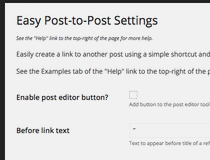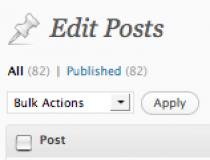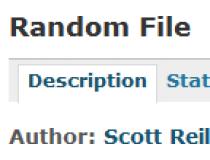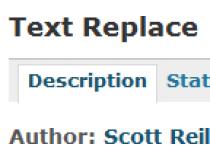The plugin allows to filter and set the number of posts per page, pages per page, and comments per page that appear in the admin listings of posts, pages, and comments.By default, WordPress lists only 15 posts in the admin listing of posts and 20 for...
- Home
- Scott Reilly
Popular software

Easy Post-to-Post Links 12 Apr 15

Admin Per Page Limits 21 Jul 15

Linkify Tags 1 Mar 15

Random File 28 Feb 15

Linkify Authors 1 Mar 15

Extra Sentence Space 28 Feb 15

Text Replace 25 Feb 15
Must have Software for Scott Reilly
Allow Multiple Accounts 3.0.4 updated
By default, WordPress only allows a single user account to be associated with a specific email address.This plugin removes that restriction.An admin settings page (accessed via Users -> Multiple Accounts or via the Settings link next to the plugin on...
Easy Post-to-Post Links works via a series of shortcodes, which when used in the content allow the user to easily link to other posts without adding classic HTML links in the text.The benefit of this method is that editors can link to a WordPress ID...
By default, the Recent Comments admin dashboard widget only shows an minimized and truncated version for the comments.This plugin gives users the possibility to expand those comments and read them all through.It adds a link at the end of the comment...
Extra Sentence Space 1.3.2
This plugin comes to counteract browser behavior to collapse consecutive spaces in display windows.This plugin adds a non-breaking space after sentence-ending punctuation to retain the appearance of the two-space intent.Installation:Unpack and upload it...
This is similar to having the features of multiple plugins into a single one.Installation:Unpack and upload it to the /wp-content/plugins/ directory.Activate the plugin through the 'Plugins' menu in WordPress.What is new in this release:Fix fatal...
Hide Broken Shortcodes 1.7 updated
It can be used to clean up messy code and avoid breaking points in blogs whenever a plugin fails.If the shortcode is of the self-closing variety, then the shortcode tag and its attributes are not displayed and nothing is shown in their place.If the...
If File Exists 2.2.2
If File Exists makes available to developers the c2c_if_file_exists() WordPress-specific PHP function that can be used to check the presence of a file in the upload directories.Variants of the function are also available to check for files in the themes...
Linkify Authors 2.1.2
This can be used on blogs where the platform does not automatically link the authors markers to their own page.Installation:Unpack and upload it to the /wp-content/plugins/ directory.Activate the plugin through the 'Plugins' menu in WordPress.What is new...
Linkify Categories 2.1.2
This can be used on blogs where the platform does not automatically link the category string to their own page.Installation:Unpack and upload it to the /wp-content/plugins/ directory.Activate the plugin through the 'Plugins' menu in WordPress.What is new...
Popular software

Easy Post-to-Post Links 12 Apr 15

Linkify Authors 1 Mar 15

Admin Per Page Limits 21 Jul 15

Hide Broken Shortcodes 11 Apr 15

Extra Sentence Space 28 Feb 15

Linkify Tags 1 Mar 15

If File Exists 28 Feb 15